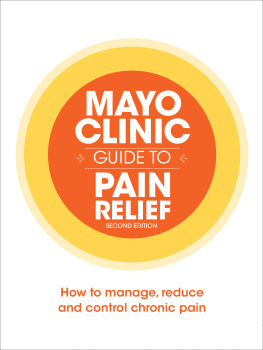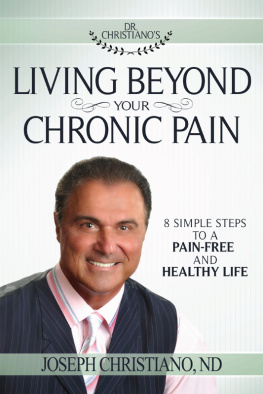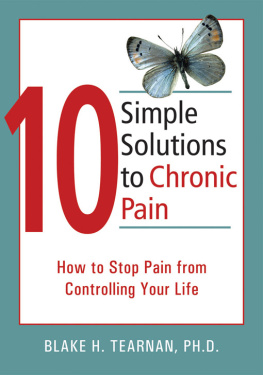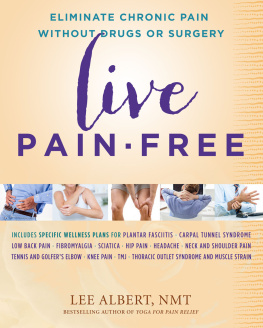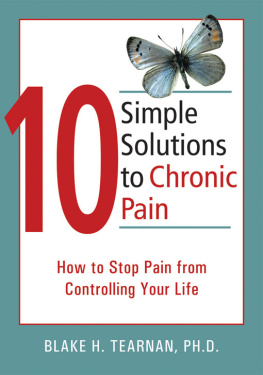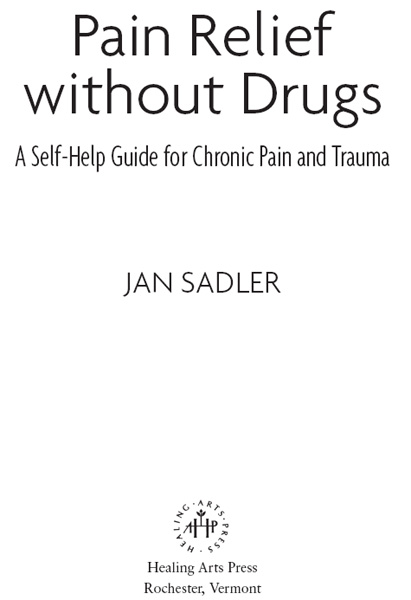
For Colin, my constant source of love and encouragement
Acknowledgments
I am deeply grateful to all those who have contributed in any way to the making of this book.
An enormous thank-you to: the late professor Patrick Wall, for reading the manuscript and most kindly writing the foreword; Dr. Chris Wells, Consultant in Pain Relief, Liverpool, for his supportive comments and his practical suggestions and ideas at the editing stage; Dr. Brian Roet, for reading the manuscript and for his encouraging words.
A special thank-you to all my family and friends for their love, support, and encouragement. And, finally, my gratitude to all the people in pain who have written to me over the years.
Foreword
I applaud Jan Sadler for writing this book and urge her readers to cherish and relish it as they would a good new friend.
There are some pains that physicians and surgeons can take away, and they are welcome to them. I dont think that readers of this book have pains of this type or they would have no reason to be even this far into the book. One pain of this sort is the dreadful stabbing pain in the face called trigeminal neuralgia. Most people with this pain respond wonderfully to tablets, and if they do not, simple, safe, highly effective neurosurgery stops the pain. For this pain doctors and surgeons can act in their traditional authoritarian way. They can take away the pain as a welcome act of theft with little need to involve the victim. How nice it would be if all pain treatment was like that: the equivalent of taking a splinter from the hand. Many doctors and some patients act as though it were this way. The doctor issues a prescription and orders, Take these three times a day and come back and see me in a month. The passive, obedient, good patient announces, I am under the doctors orders.
In the real world, there are far more common pains, such as arthritis, where this attitude not only is not common but also leads to anger and frustration for both doctor and patient. It is true that tablets and sometimes surgery can lead to considerable improvement, but they do not wipe out the pain in the dramatic way the first type of pain can be treated.
Many years ago I witnessed treatment in hospitals in China. I was delighted and astonished by the relaxed and cooperative atmosphere. As a foreigner, I often had difficulty in distinguishing staff from patients. I was repeatedly told, We recruit the patient to be a member of his own treatment team. That is what all doctors should do and what all patients should demand. The patient must be informed and involved so that the team can achieve the best possible results. Jan Sadlers book helps in this cooperative effort.
Last, there are some types of pain, such as fibromyalgia, where the greatest experts in the world do not yet understand their origin and no medicine or surgery can specifically wipe them out. In some ways these are the worst types of pain because they isolate the victim. Some old-fashioned doctors and even friends and relatives tell the victim There is nothing wrong with you because there is no detectable cause for their pain. No one can find the splinter at the site of the pain. The victims are abandoned and sad. Now comes Jan Sadler, who believes in the reality of these peoples pain and suffering. She has been through it herself. She shows a path, which requires bravery, in which the patient adopts some of the responsibility to explore and aid his or her own condition.
For those of us who work professionally on the problems of pain, we must redouble our efforts to discover the origin of pains, particularly those of unknown cause and those treated with ineffective therapies. For all of us, in or out of pain, we should applaud those who struggle to understand their personal pains and to bring them under the forms of control this book describes.
PROFESSOR PATRICK D. WALL, DOCTOR OF MEDICINE, FELLOW OF THE ROYAL SOCIETY, FELLOW OF THE ROYAL COLLEGE OF PHYSICIANS
Patrick Wall (19252001) was a renowned neuroscientist whose research into the mechanisms of pain led to several new forms of pain treatment, including the TENS (transcutaneous electrical nerve stimulation) machine, which interferes with pain pathways from the spine to the brain. He was professor of anatomy at University College London from 1967 to 1990 and then emeritus professor based at St. Thomass Hospital. Early in his career he spent time in the United States, teaching at Yale, the University of Chicago, Harvard, and MIT. He co-edited the first textbook on the subject of pain, Textbook of Pain, and founded Pain, the premier journal of the field. He left behind a legacy of associates and students to continue his pioneering research.
Introduction
The natural healing force within each one of us is the greatest force in getting well.
HIPPOCRATES
I t doesnt matter where the pain is, how intense it is, how long you may have had it, or what caused it: you will find relief from that pain in this book. You, like me, already have the capacity to reduce your own pain. You have hidden powers and strengths deep inside yourself that are the means of energizing your own natural healing powers. With the practical activities in this book you can release and maximize your full healing and pain-relieving potential.
After a back injury and operation, I found that drug therapy alone was unsatisfactory in dealing with the pain and so I began to develop my own personal coping strategies. On my journey I made many wonderful discoveries about my own natural inner powers to reduce pain and discomfort, to make changes and to regain control of my life. My success led me to make programs for others on how to cope not only with pain, but also with how it affects many aspects of our lives. Eventually I put this book together for all those who are looking for a way to help themselves. I live with pains challenges daily, and so the book is written from my personal knowledge and experience of techniques that work for me and for thousands of other people, and they will work for you too. When I was first struggling with pain, there was little support available; this is the book I would have liked to have kept by me.
The way you experience your pain is closely linked in a unique way with your own personal reactions. Your personal reactions are within your own power to influence and change. The techniques in this book will show you how to make the changes you desire. The book has a structured but flexible approach and is packed with ideas that will enable you to have a new dynamic sense of being in charge of your situation and will help you to reduce and live more peacefully with your pain. As well as helping you to lessen your physical discomfort, this book will also show you how to foster your self-esteem and how to lead a fuller, more enjoyable life.
Work at your own pace with the techniques in the book, and please dont tackle too much when you start. You may feel like taking on some of the ideas now and some perhaps in a few weeks, months, or even in a year or so. Remember, you dont have to do it all at once. One step at a time, thats all we can do. Be gentle in your approach and use the techniques with an attitude of respect and kindness toward yourself. Enjoy the activities: they are written in your best interests, for your good and your benefit. Do listen to the recording that accompanies this book. As well as adding another dimension to your experience, it will enhance your understanding and enjoyment of the relaxation and visualization exercises.
The techniques in this book are meant not necessarily to replace any treatment, conventional or alternative, you may be having, but to be used alongside it as a complement. Even if you are having treatment of some kind,
Next page

